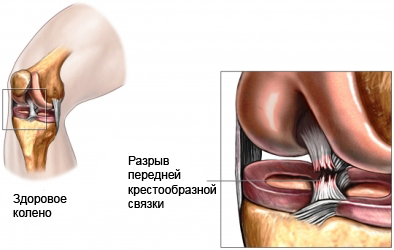Surgery of the anterior cruciate ligament
Description of operations on the anterior cruciate ligament
This is an operation to rebuild the anterior cruciate ligament in his knee after the break. Often to repair a torn ligament graft used, Execution of the tendons.

The reasons for performing surgery on the anterior cruciate ligament
Operation PKS – Election procedure. It means, that the operation is not always necessary – it may depend on the lifestyle and age of the patient. The decision to have surgery should be made after consulting with your doctor about:
- Sports and professional needs;
- Condition of the knee joint;
- Other knee injuries.
Surgery may be recommended if there is:
- Complete ACL rupture;
- Instability of the joint;
- Knee injuries, which affects more than one ligament;
- If you want to return to sports or other activities, which require physical activity or movements;
- If there is no improvement in the application of rehabilitation therapy.
Possible complications during an operation on the anterior cruciate ligament
Before, how to perform the operation, you need to know about possible complications, which may include:
- The instability of the knee joint (new rupture or ligament sprain);
- Improper reconstitution of SCC;
- Pain in the ball of the foot after surgery;
- Skovannosty in knees;
- The loss of full range of motion;
- Numbness;
- Infection;
- Bleeding;
- The formation of a blood clot;
- Reaction to anesthesia.
Factors, that may increase the risk of complications include:
- Smoking.
How is surgery on the anterior cruciate ligament?
Before the procedure
Before the surgery, the doctor may prescribe:
- Inspection and blood tests;
- X-ray of the knee – to take a picture of structures inside the body, especially bones;
- MRT – test, which uses magnetic waves, to make pictures of structures inside the knee;
- It may be necessary to discuss the type of anesthesia, to be used and the potential risks of its use.
It may be necessary to stop taking some medicines for a few days before surgery:
- Aspirin or other anti-inflammatory drugs;
- Blood thinners (eg, warfarin, Clopidogrel);
Other procedures, which can be assigned to the operation:
- Often before the operation requires physical therapy;
- We need to avoid eating and drinking for 6-8 hours before the procedure.
Anesthesia
It will be used total or spinal anesthesia, that will block any pain. When using general anesthesia the patient will sleep all the time of surgery. It is administered intravenously in the arm or hand. When using spinal anesthesia doctor may give a sedative, to alleviate anxiety.
Procedure operations on the anterior cruciate ligament
The IV is placed in a vein for administering medications and supporting liquids. A doctor examines a range of motion of the knee joint, to determine the degree of ligament rupture. Then the doctor finds another tendon in the knee or hamstring (the so-called autograft), to repair a torn ligament. Sometimes a donor transplant (It called allograft). The doctor creates a tendon graft to size.
One or two small incisions are made on top of the knee. Arthroscope (or an endoscope) and tiny instruments are inserted into the knee joint. Torn ligament is removed and restored knee injury. For, to reconstruct the tendon, doctor drill holes through the bone structure in the thigh and lower leg. The new graft is performed through these openings. To fix the graft in place can be used sutures, which are passed through the holes and secure the new tendon, as well as other devices (eg, bolts, Washers, staples).
Once the graft is securely fastened, doctor checks a knee range of motion. If necessary, performed other tests. The incisions in the skin sutured. Knee bandage is applied and / or bandage.
How long does the surgery?
The operation takes about two hours.
Will it hurt?
Anesthesia will prevent pain during the procedure. Pain or soreness during recovery cured painkillers.
The time spent in hospital
This procedure is performed in a hospital. The patient can go home the day of surgery. If there are complications, perhaps, will have to stay in hospital.
Postoperative care after surgery on the anterior cruciate ligament
In the hospital
After the procedure, the hospital staff may provide the following care:
- Monitor vital parameters before the termination of anesthesia;
- To provide pain medications if necessary;
- Apply an ice pack on his knee;
- Learn to use crutches, to reduce the load on the knee.
At home
Houses need to do the following, to ensure the normal recovery:
- Take prescribed painkillers;
- Use crutches since, until the knee is fully recovered. It may take 2-6 weeks;
- Work with a physical therapist;
- Gradually increase the load, to swim or ride a bike, to strengthen the knee joint;
- Keep the incision area clean and dry;
- We need to ask the doctor about, when it is safe to shower, bathe, or to expose the surgical site to water.
It is necessary to go to the hospital in cases
- Redness, edema, strong pain, bleeding, or discharge from the incision site;
- Inability to relieve pain using painkillers;
- Signs of infection, including fever and chills;
- Numbness in the knee;
- Nausea and vomiting;
- Problems with urination;
- Inability to eat or drink;
- Any other issues.
It is necessary to call an ambulance in case of
- Shortness of breath or chest pain;
- Swelling, pain, or fever in calves.
